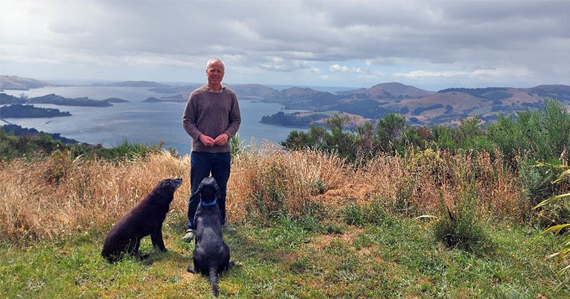-
-
Cr Bryan Scott
-
-
-
-
-
-
-
-
-
-
-
-
-


High above Otago Harbour, Cr Bryan Scott’s home looks down on Quarantine Island, looking back into a past of sailing ships and pioneers pitted against the elements. Up here, the rock walls early farmers built still remain, and the native trees they cut down are being replaced. Bryan has planted 3500 natives in amongst the broom, which shelters them from the wind while they grow — very slowly. “They’ll get there,” he says.
The welcome committee is black of fur and wet of nose: India, 15 years old, a graceful dowager with a bit of a limp, and Awa, 2 years old and leaping about with the exuberance of puppyhood.
Matter-of-fact, the kind of person who does exactly what it says on the tin, Cr Scott is a straightforward guy. “I try to be a reasonably open book. I don’t have a master plan; I’m just trying to do my bit.”
Wearing a scratchy wool jersey, tent drying out on the living room floor, looking every bit as if he has just returned from a 10-day tramp (because he has), he likes testing himself in nature. “That’s how I grew up, on a rough, hill country farm. I used to do mountaineering, and tramping is keeping the candle alight.”
Bryan trekked the South Island section of the Te Araroa Trail in 2020 and wrote a book about his experience, My Trail, Te Wai Pounamu. “I’d never written a book, so I thought I’d have a crack at it.”
Describing his house as ‘a DOC hut on top of a mountain,’ he bought the land 15 years ago and has covenanted some with the DCC, meaning it is protected forever. After putting in the road, his current project is digging a public walking track to connect the two halves of the Burns Reserve — which folds around his property — planting bush to unite the two sections named, not after the rollicking, roistering Robbie, but the godly Thomas Burns, keen tramper and huge sideburns-wearing spiritual leader of the Scots settlers.
Hunting and diving with son Ronan means there’s an unlimited supply of venison and fish through this place at the moment. It’s the sort of resilience and tenacity rural folk tend to have. And you might need to have the capacity to dig in when you’ve been on the Otago Regional Council for six terms, or 18 years. Bryan’s seen a lot of change in that time. “Over history, the balance [at council] has been more pragmatic, looking after agricultural well-being and environment as well as they can. There’s been a constant tension. It’s only in this term that the council has become greener and that does bode well, particularly at this crucial juncture. We have some important decisions to make.”
“Climate change has accelerated a sense of urgency about the work needing done. Our regulatory reports indicate that things are changing; however, there’s still a hell of a lot of work to do. Of the waterways we monitor, a third of these sites indicate degradation. Still, people think, ‘oh, that’s someone else’s problem’.”
“When I did the Te Araroa Trail, you’re up at the headwaters of the rivers, and generally, the environment there is very good. You get to experience the way our environment was. While down in the lowlands, we need to aspire to be better than we are. It’s happening at long last —better late than never — we’re realising our environmental responsibilities.”
Can we get things back to the way they used to be?
“If we can’t restore them to the way they were, we can still do a bloody good job. We can die trying.”
